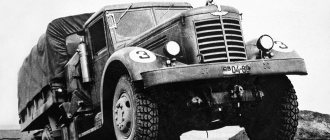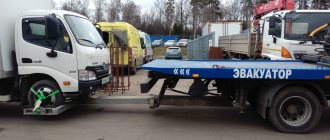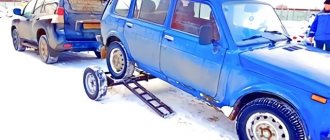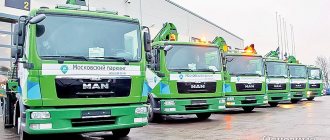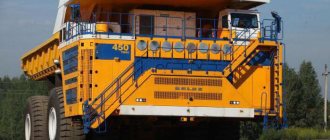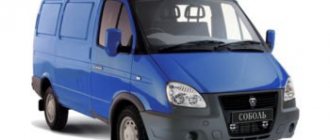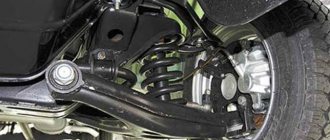Maximum permissible dimensions and weight of truck transport
1.1. Maximum length, m
of a truck. 12.0 bus. 12.0 trailer. 12.0 articulated vehicle. 20.0 articulated bus. 18.0 road trains. 20.0
1.2. Maximum width, m
all vehicles. 2.55 isothermal vehicle bodies. 2.60
1.3. Maximum height, m. 4.0
2. The maximum dimensions of vehicles specified in paragraph 1 of this Annex include the dimensions of swap bodies and cargo containers, including containers.
3. When moving, any vehicle must be able to turn within a space limited by an outer radius of 12.5 m and an inner radius of 5.3 m.
4. The maximum distance between the coupling locking pin and the rear of the combination vehicle must not exceed 12.0 m.
5. The maximum distance, measured parallel to the longitudinal axis of the vehicle combination, from the outer front point of the body or loading platform behind the cab to the rear outer point of the trailer, less the distance between the rear of the towing vehicle and the front of the trailer, shall not exceed 17.0 m.
6. The maximum distance, measured parallel to the longitudinal axis of the road train, from the outer front point of the body or load platform behind the cab to the rear outer point of the semi-trailer must not exceed 16.4 m.
7. The load installed in the body of the vehicle must not protrude beyond the rear outer point of the vehicle or trailer by more than 2.0 m.
8. The distance between the rear axle of the truck and the front axle of the trailer must be at least 3.0 m.
9. The horizontally measured distance between the semi-trailer's pivot point and any point on the front of the semi-trailer must not exceed 2.04 m.
10. The length of the vehicle must be measured in accordance with paragraph 6.1 of ISO 612-1978. In this case, when measuring length, the following devices mounted on the vehicle are not taken into account:
- glass cleaning devices and splash guards;
- front and side marking plates;
- devices for sealing and protective devices for them;
- devices for securing tarpaulins and protective devices for them;
- equipment for electric lighting;
- rear-view mirrors and devices for viewing the space behind the car;
- air tubes;
- lengths of valves and connectors for connection to trailers or swap bodies;
- steps for access to the body, a lift for a spare tire;
- lifting platforms, access steps and other similar equipment not exceeding 200 mm in operating position and designed in such a way that they do not increase the vehicle's loading weight limit set by the manufacturer.
11. The height of the vehicle must be measured in accordance with paragraph 6.3 of ISO 612-1978. Moreover, when measuring height, antennas mounted on the vehicle and the pantograph in the raised position should not be taken into account.
For vehicles equipped with an axle lifting device, the effect of this device must be taken into account.
12. The width of the vehicle must be measured in accordance with paragraph 6.2 of ISO 612-1978. In this case, when measuring the width, the following mounted on the vehicle are not taken into account:
- devices for seals, seals and protective devices for them;
- devices for securing tarpaulins and protective devices for them;
- protruding parts of mudguards;
- devices for identifying damage to tires;
- Lightning equipment;
- steps, suspended platforms and other similar equipment, which in working position protrudes no more than 10 mm from each side of the vehicle, in which the corners of the steps facing forward or backward have a radius of curvature of at least 5 mm, and their edges have a radius of curvature of at least 2.5 mm:
- rearview mirrors;
- tire pressure indicators;
- steps or ladders that retract or retract for transport;
- a curved portion of a tire's surface that extends beyond its point of contact with the road surface.
Maximum vehicle weights
1. The maximum weight of vehicles must not exceed the values given below, t
1.1. Trucks:
two-axle car. 18.0 three-axle vehicle. 24.0 three-axle vehicle having a drive axle consisting of two pairs of wheels equipped with air or equivalent suspension. 25.0 is a four-axle vehicle with two driven axles, each of which consists of two pairs of wheels and has air or equivalent suspension. 32.0
1.2. Vehicles forming part of a combination vehicle:
two-axle trailer. 18 three-axle trailer. 24
1.3. Combined vehicles
1.3.1.* Semi-trailer trains:
a two-axle tractor with a two-axle semi-trailer with a distance between the axles of the semi-trailer of 1.3 meters or more, but not more than 1.8 meters. 36.0 two-axle tractor with a two-axle semi-trailer, with a distance between the axles of the semi-trailer exceeding 1.8 meters. 38.0 two-axle tractor with three-axle semi-trailer. 38.0 three-axle tractor with two-axle semi-trailer. 38.0
1.3.2.** Trailed road trains:
two-axle truck with two-axle trailer. 36.0 two-axle truck with three-axle trailer. 42.0 three-axle truck with two-axle trailer. 42.0 three-axle truck with three-axle trailer. 44.0 three-axle truck with four-axle trailer. 44.0
1.4. Buses:
biaxial 18.0 triaxial. 24.0 three-axle articulated. 28.0 four-axle articulated..28.0
Maximum axle weights of vehicles***
Equipped with CMU
In recent years, a tow truck with a crane-manipulator installation has been deservedly considered the most universal type of transport, designed to move almost any faulty vehicle. At the same time, it is possible to transport machines of any type, regardless of the tonnage and the degree of damage or malfunctions received.
A tow truck with a CMU consists of a horizontal loading platform fixedly mounted on the chassis and a crane installed between it and the driver’s cabin. The most important component of such a tow truck is the crane, on whose functional qualities (load capacity, boom reach, maneuverability) the operation of the entire system as a whole depends. Loader cranes are supplied by various manufacturers and vary in price and quality. When ordering from a crane, you must pay special attention to the parameters of the crane, its origin, the possibility of obtaining spare parts for the crane, and the terms of service and warranty of the crane.
The most important advantages of this type of tow truck are increased mobility and maneuverability, compact dimensions and wide functionality. Such tow trucks can be used in a wide variety of areas. A crane loader will come to the rescue in a situation where a regular one with a winch simply cannot perform its functions, for example, it is impossible to approach a faulty vehicle or it is in a hole, on a curb, or in another similar situation.
To simplify the solution of such problems, auto tow trucks with CMU are equipped with various additional equipment, such as:
- winch;
- wheel type grip;
- various platforms, etc.
To load a car onto a straight or broken type device, a crane with a retractable boom is used, which allows you to move loads. The radius of movement for various models of equipment can be from 5 to 10 meters. At the same time, this method of transportation on a platform is considered the most effective and reliable today due to a number of undeniable advantages.
Advantages of special transport: the ability to transport vehicles with significant damage, such as blocked doors or wheels, breakdowns of the gearbox, engine, steering, etc., as well as the ability to evacuate almost any type, including heavy and large vehicles.
Advantages
- The ability to safely load a vehicle to be evacuated in the presence of obstacles on the road (other cars, structures, snowdrifts), as well as from hard-to-reach places (ditches, failure of the roadway, etc.).
- Ability to load with wheels locked by the brake (without the participation of the owner) or due to severe damage.
- Possibility of unloading onto an elevated platform or pedestal for repairs or exhibition presentation.
- Ability to work in confined spaces (no space required for traveling, extending ramps, etc.).
- Possibility of transporting other goods (construction materials, goods in boxes and containers, etc.).
Tow truck and manipulator
To lift and transport a loaded truck, bus or construction equipment, one powerful tractor will not be enough. For this purpose, modern tow trucks are equipped with hydraulic manipulators with winches and automated gripping mechanisms. Using this device, the damaged vehicle is lifted by the front or rear axle and towed in this condition.
One important point when towing a truck is to properly ensure safe transportation. When towing a car by partially loading it, the load on the front axle of the towed vehicle is sharply reduced, and this leads to a deterioration in its handling and can lead to an emergency situation on the road. And to avoid this, the front part of the towed vehicle is specially weighted.
When is a sliding platform required?
A sliding platform is a straight metal platform that is lowered at an angle from the body of a tow truck, facilitating the placement of vehicles and its evacuation. This mechanism is used when the wheels of the car are not blocked. Otherwise, loading the vehicle onto a tow truck will be problematic, and removing it will be even more difficult.
Important!
A tow truck with a sliding platform is classified as a special equipment with a full load.
Most often, this tow truck model is used in the following situations:
Operating principle of the cargo tow truck mechanism
Although all the equipment of a cargo tow truck is designed to work as a single mechanism, the main traction load usually falls on one winch, while the second one helps to keep the damaged vehicle in an upright position. This is very important if you need to evacuate a car with cargo in the back or expensive special equipment. This design will allow you to avoid breaking the geometry of the victim’s frame, which is almost inevitable when pulling a car out of a ditch with a conventional truck crane or tractor.
In addition to the main possibility of “gentle” evacuation of almost any car, another advantage of partially loaded tow trucks is their small size, which allows them to easily pass through even the busiest places, arriving at the scene of the accident in a short time.
Tow truck
A tow truck is a vehicle specially equipped for transporting, loading and unloading cars. As a rule, it is used to deliver a car to a repair site (for example, after an accident) or to a parking lot in case of violation of parking rules. A tow truck is similar to a truck, equipped with a winch or a crane, with a special platform (platform) instead of a body. Additionally, the tow truck is equipped with fasteners that serve as a holding device that prevents the vehicle from rolling off the platform. The tow truck platform itself is similar to an overpass, and this makes it easier to lift the car on board.
Legislative nuances
The modified vehicle must be registered with the traffic police.
Registration
You can register the vehicle yourself or seek help from a lawyer. Specialists from companies involved in equipment conversion also offer the customer additional services for preparing registration documents with the traffic police.
What rights are needed?
To drive a tow truck based on a GAZelle, you need a category B license.
Tow trucks can be divided into several types:
- Tow truck equipped with a winch. Thanks to the presence of a winch (either hydraulic or electric), it is capable of fully or partially loading the car.
This type of tow truck is the most common and can be found on the roads more often than others. It is a tow truck with a winch that takes away improperly parked, damaged cars (as a rule, these are passenger cars). The sliding winch moves transversely, so when loading a car, the location of the tow hook does not matter. Domestic brands: GAZ-3307/09 “Lawn”, GAZ-33 104 “Valdai”, GAZ-33 02 “Gazelle”, MAZ-437 040 “Zubrenok”, KAMAZ-43 08, KAMAZ-43 118, ZIL 53 01 “Bychok”, AMUR-43 46. Popular foreign brands: ISUZU-NQR 71P, Hyundai-72, Scania R113M, DFAC-10 45, BAW-6F, etc. - Tow truck manipulator. This type is most suitable for cases when a car needs to be towed from a roadway that is densely crowded with other cars. In the modern situation on the roads, sometimes you simply cannot do without this type of car evacuation. A tow truck with a manipulator is able to quickly load and remove a vehicle from the scene of an accident or emergency stop. Such a tow truck can easily perform the following tasks: transportation of a new car, evacuation of cars with breakdowns in which further independent movement becomes impossible and possibly dangerous, as well as evacuation of cars from a ditch, transportation of “shells” and specific cargo (transportation of metal structures, bricks, building materials). The platform of such tow trucks is broken or straight. Domestic brands: GAZ-3307/09 “GAZON”, GAZ-33 104 “VALDAI”, KAMAZ-43 08, KAMAZ-431 18, MAZ-437 040 “Zubrenok”, GAZ-33 07/09, GAZ-33 104 “Valdai”, Amur 43 46. Popular foreign brands: Hyundai-72, ISUZU-NQR 71P, etc. There are tow trucks with a broken and straight platform. Both one and the second type of tow trucks are equipped with a traverse. A traverse is a crossbar whose task is to hold vehicles in a horizontal position.
- Tow truck with a shifting platform. It has a sliding platform and a winch (electric or hydraulic sliding), thanks to which any car can be evacuated. This type can also be equipped with dolly trolleys (if the wheels of the vehicle being transported are blocked), auxiliary platforms (if the vehicle has low ground clearance), and fastening belts. Domestic brands: MAZ-437 040, MAZ-437 040, GAZ-33 104 Valdai, KAMAZ-43 08. Popular foreign brands: ISUZU-NQR71P, Hyundai-72, etc.
- Tow truck for cargo and heavy-duty vehicles (freight tow truck). Such a tow truck allows you to place the car entirely or partially on the platform (only the front or only the rear part of the car is placed on the platform). As a rule, when evacuating freight transport, additional equipment and special equipment are required. Such tow trucks can transport equipment weighing up to 40 tons. Popular brands: KAMAZ-65 20, VOLVO FH-12, KrAZ-255 B1, etc.
Description of the device of a tow truck with a sliding platform
The design of any tow truck with a sliding platform includes several basic elements:
Sometimes tow trucks with a sliding platform are equipped with a crane-manipulator unit. This allows you to expand the capabilities of the equipment, but increases the cost and reduces the load capacity of the machine.
The platform is usually made from high-strength low-alloy steel, which is lighter than regular steel. This reduces the total weight of the tow truck, thereby reducing fuel consumption and increasing the maximum load capacity.
The flooring for the wheels is made of corrugated steel 3 mm thick. The control unit is placed in a plastic box, which protects the mechanisms from moisture and debris.
There are two types of tow trucks with a sliding platform - with and without a crane-manipulator. The model with CMU is more expensive, but also more versatile because:
Models with a hydraulic lift truck are additionally equipped with two hydraulic outriggers to ensure the stability of the tow truck during loading. The CMU itself is equipped with a hydraulic rotator and traverse, which ensure a level position of the vehicle during loading, regardless of its center of gravity.
One of the popular models of tow trucks with a sliding platform is installed on GAZelle. The machine has a high rear overhang, which allows you to pick up the machine from a curb or from a small hill.
Another commercial truck used as a chassis for tow trucks is Hyundai. For example, HD-78 with a five- and six-meter sliding structure.
Source
Truck brands by load capacity category
Do you want to know the carrying capacity of vehicles for transporting goods? Here are tables of truck load capacity by brand and tonnage.
Trucks with different categories of carrying capacity are used to transport goods. Trucks of category N1 are used to transport from one to three tons. This means that their maximum gross weight should be no more than 3.5 tons. For transportation from five to ten tons, trucks of category N2 (gross weight from 3.5 tons to 12 tons) or N3 (over 12 tons) are used. To transport cargo weighing up to twenty tons, trucks of category N3 (total weight over 12 tons) are used.
What types of car evacuation exist?
A special tow truck is used to force vehicles to move. For vehicles of different tonnage, different transport and loading devices are used.
Dear readers! The article talks about typical ways to resolve legal issues, but each case is individual. If you want to find out how to solve your particular problem , contact a consultant:
+7 (Saint Petersburg)
APPLICATIONS AND CALLS ARE ACCEPTED 24/7 and 7 days a week.
It's fast and FREE !
Every driver should know the types of tow trucks so that they can quickly navigate when the need arises to move a slow-moving vehicle over long distances.
It is important to study the cases in which a towing service for vehicles is called, as well as what prices for such services are currently offered on the service market.
What are there
For violations of parking rules, in a post-accident situation, or under other circumstances, the vehicle must be towed to a parking lot, a repair shop, or somewhere else.
This is done with the help of tow trucks - motor transport devices, tractors on wheels, with a special (loading) platform.
The following types of evacuation procedures exist:
- Full loading of the car.
- Partial loading of a car (also called towing).
- With lifting on a winch.
- With arrival on the platform.
- For transporting heavy vehicles.
- For transportation of light vehicles and motorcycles.
- With loading only from the side onto the platform.
- With direct loading onto the platform.
- With fixation on a winch.
- With fixation on the platform.
- Transportation of one car.
- Transportation of several cars at once.
Transportation of vehicles must be carried out taking into account their weight and the carrying capacity of the transport vehicle.
Let's look at a standard example:
| Permitted vehicle weight | 3 tons, if you take into account the transportation of cargo |
| Weight of the machine without load | 1.5 t |
| You should take a tow truck that can transport cars | weighing from 1.5 to 1.9 tons |
Now let's look at a practical example:
| Weight of Ford Focus car | is 1.3 kg |
| You need to select a tow truck for it, which has its own mass | not less than 1.3 kg |
| In this case, the tow truck must have its own parameter for the permissible weight of the transported vehicle. | For the Ford in question, you need equipment with a load capacity of 2.3 kg or more |
The calculations here are very simple - the weight of the car that needs to be transported is subtracted from the maximum permitted weight, and the result is the weight that can be transported by a tow truck.
Accordingly, the tow truck itself is selected after the obtained calculation results. One should also keep in mind the deviation from this classic example when making calculations. It makes up 10-20% of the mass.
In what cases are they used?
The reasons why vehicles are transported can be different - from private needs to compliance with legal regulations.
The procedure for evacuation for violations committed by a motorist implies that the traffic police officer must first obtain consent from the driver.
Such consent is confirmed in writing by a signature in the protocol on the administrative offense.
Illegal towing of a car to a parking lot by traffic police can be appealed by the driver within 10 days from the date of signing the protocol.
But there are exceptions when the police have the right to take the car to the parking lot themselves. They are guided by Art. 27.13 of the Code of Administrative Offenses of the Russian Federation, which is called “Detention of a vehicle.”
Also - Order of the Ministry of Internal Affairs of the Russian Federation No. 185 of March 2, 2009 (Chapter III, paragraphs 146-148), which was last amended on December 22, 2014, and other legislative provisions.
For example, here are cases where the law allows for the forcible removal of cars or trucks in the absence of their drivers, or without asking the driver’s consent.
The person driving the car committed violations under the Code of Administrative Offenses of the Russian Federation. Let's consider cases in which cars are forcibly confiscated from drivers who have committed violations under Art. 27.13.
This article of the law lists links to other articles of this Code - Art. 11, 12 and 14 Code of Administrative Offenses of the Russian Federation:
- your state of intoxication due to the use of alcohol or drugs (part 1.3 of article 12.8);
- driving a vehicle without proper documentation (part 1 of article 12.3);
- unauthorized driving of a vehicle (part 1.2 of article 12.7);
- No one can bring forgotten documents to the driver (provided for all cases of offenses that are not eliminated within 10 minutes);
- parking, parking, temporary stopping in an unauthorized place or illegally crossing road markings (part 4.5 of article 12.16, parts 2, 3, 3.1 and 4 of article 12.19);
- improper transportation of goods or children;
- driving faulty vehicles - broken brakes, steering wheel (Part 2, Article 12.5).
Source: https://twikki.ru/kakie-sushhestvuyut-vidy-evakuatsii-avtomobilej/
Brands of trucks up to 1 ton
Freight vehicles up to 1 ton are in steady demand. Depending on their needs, customers will be able to select options with the appropriate dimensions and body type. These vehicles are a reliable business partner, the maintenance of which is simple and affordable. Freight vehicles up to 1 ton are characterized by compact dimensions, which affects high maneuverability and fairly economical fuel consumption. In this category, consumers will be able to choose a car with an open, closed and isothermal van.
Brands of trucks up to 2 tons
Freight transport up to 2 tons is suitable for transporting small cargo. It is worth noting that these machines come in different sizes and varieties, with the same permissible load. The body of these vehicles can be tented, open or in the form of a van, including a combined all-metal one. It is worth noting that sizes vary by brand and model. According to the wheel formula, which determines the cross-country ability of a car, there are 4x2 and 4x4. The latest vehicles are ready to move even in off-road conditions.
Brands of trucks up to 3 tons
JAC HFC1045K2 (onboard)
Vehicles up to 3 tons are a viable option for transportation in the city and delivery of products over short distances. They are convenient for working in urban environments, thanks to their fairly compact size. These vehicles have different dimensions. They can be in the range of 1.8-2.4 m wide, 1.7-2.5 m high and 3-6.5 m long. The bodies of these vehicles are represented by: a van, an awning, a side (open), a refrigerator, a thermokung, side with a pyramid (a vehicle for transporting glass), a tow truck.
Brands of trucks up to 5 tons
The purpose of vehicles up to 5 tons is cargo transportation over short distances. Manufacturers have offered modifications with a 4x2 and 4x4 wheel arrangement. These solutions are convenient for transporting products/cargo from warehouses to stores or in another sequence located close to each other, as well as for residential and office moves. The bodies of these vehicles are represented by vans, tilt booths, refrigerated booths, the sizes of which are different, which allows consumers to easily make appropriate decisions.
Advantages of the new GAZelle Business
- load capacity up to 1.5 tons
- volume of transported cargo from 6 to 18 m³
- 2 drive types: 2WD and 4WD
- warranty 3 years or 150 thousand km
- Maintenance interval - 80,000 km
- spare parts are 3-5 times cheaper compared to foreign analogues
- maximum capacity up to 15 seats
- 3 chassis lengths
GAZelle Business has 4 engine options: GASOLINE / DIESEL / LPG / CNG. The UMZ-421647 CNG bi-fuel engine allows you to reduce fuel costs by up to 60%. Another serious advantage will be the price - a GAZelle with a CNG engine will be 41% cheaper than the same GAZelle, but with a gasoline engine.
The clever cargo bed is made from a single sheet of cold-rolled steel for durability and corrosion resistance.
Rear dependent leaf spring suspension is the optimal solution for trucks. It will ensure resistance to critical loads, durability and ease of repair.
The independent double-wishbone front suspension provides a large margin of safety and good ride comfort.
We offer an excellent opportunity to buy GAZelle Business at the manufacturer's price. Thanks to many years of experience, SpetsTechKomplekt has established itself as a reliable partner in the market of Russia and the CIS countries.
GAZelle Business fully meets all current safety, ergonomic and reliability standards.
The new GAZelle-Business uses components from famous world manufacturers:
- BOSCH - vacuum booster and ABS
- EATON - rear axle lockable differential
- WEBASTO - pre-heater
- HOERBIGER - gearbox and transfer case
- ZF - steering
- SACHS - shock absorbers and suspension springs
- EDAG - new instrument panel
Brands of trucks up to 10 tons
Freight vehicles up to 10 tons are ready for long-distance and international transportation. Cars with a length of 7-8 m can be equipped with a tilt, isothermal or refrigerated body. First-class vehicles are advisable if necessary to transport construction materials or equipment. Trucks of the second type allow you to unload/load products from the side, as well as perform these actions using crane equipment. Isothermal vehicles transport household chemicals that require maintaining certain temperatures. Refrigerated trucks transport cargo that needs to be constantly cooled.
Loading onto a stationary platform
The next type of tow truck has a fixed broken platform onto which the object intended for transportation is loaded using a winch. The car is rolled up along ramps, which is the main obstacle to loading models with low ground clearance. Particular problems are caused by vehicles with locked wheels - in this case, you cannot do without a dolly.
Brands of trucks up to 20 tons
Trucks up to 20 tons differ in the type of body, which can be tilted, flatbed, in the form of low-loading platforms, vans, isothermal and refrigerated, which makes it possible to transport products of any nature, including oversized cargo. For those interested in trucks up to 20 tons, the market is currently ready to offer a decent selection of imported and domestic brands. When choosing an appropriate solution, it is worth deciding on the rational type of body, wheel arrangement, load capacity, size, type and volume of the body.
The tables show that cargo vehicles differ in carrying capacity, functionality and dimensions. Some models are adapted for transportation over short distances, while others are adapted for long-distance routes. Thanks to this, consumers can fully satisfy their interests in full, selecting cars for specific needs. Today, you have the opportunity to choose among domestic and foreign brands. Having previously studied the characteristics and capabilities of the options they are interested in, clients will be able to make the right choice.

